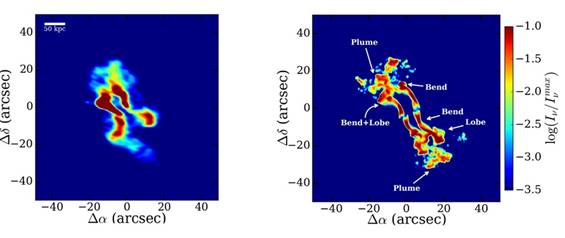Ministry of Science & Technology
Simulations decode rare twin radio galaxies twisting in space
Posted On:
21 NOV 2025 5:27PM by PIB Delhi
Researchers have reproduced the complex morphology of the most recently discovered Twin radio galaxies (TRGs) divulging secrets that are reshaping the understanding of the physics of jets that emanate from these systems. This offers a crucial step forward in understanding how black-hole–driven jets interact with the host galaxy medium, change their dynamics, deposit energy and form lobes, and influence the galaxy environment.
Twin radio galaxies (TRGs) are extremely rare objects, with only three known so far. Most galaxies are known to host a supermassive black hole (SMBH) at their centers, which evolves over time by accreting matter from their surrounding environment, forming an accretion disk around them. During this active accretion phase, they also eject a fraction of this matter in the form of two plasma jets in opposite directions, and aligned with the rotation axis of the black hole itself. These jets propagate through their ambient medium and can extend over a distance of a few million light-years. The morphology of these jets is shaped by their interaction with the surrounding medium, as they battle their way outwards. These jets are best studied through their emission in the radio wavebands.
Galaxies evolve and grow by merging with each other, and when they do so, their respective SMBHs will gradually sink toward each other due to stellar dynamical friction and/or energy dissipation, ultimately forming a binary or a dual-SMBH system.
Very rarely, during such a merger of two massive galaxies, both their SMBHs may emit bipolar jets resulting in Twin Radio Galaxies, or TRGs. Only three such TRGs have been discovered so far, with each twins emitting a pair of oppositely directed jets. The third TRG, named TRG J104454+354055, was discovered only in 2022 using data from India’s upgraded Giant Metrewave Radio Telescope (uGMRT) near Pune. The other two TRGs were discovered more than 3 decades ago.
In this newly discovered TRG, both sets of radio jets are discernible out to a distance of 0.3 million light-years each, along with clearly seen helical and bending structures along their lengths. The two SMBHs are themselves separated by around 0.1 million light-years.
A team led by astronomers at the Indian Institute of Astrophysics (IIA), an autonomous institute of Department of Science and Technology (DST), used 3-D hydrodynamical simulations to reproduce the complex morphology of the recently discovered TRG. The researchers found that both bipolar jets remain well-separated and propagating in parallel with helical morphology without any interaction between them, comparable with the observation.
Their study published in the Astrophysical Journal proved the crucial role played by the slow swiveling (like a spinning top wobbling as it slows down) or precession of the twin plasma jets emanating from the two supermassive black holes in this system to form the observed structures.
“The newly discovered TRG offered a rare opportunity as a unique testbed to try and understand such complex systems. Despite their clean morphology, we hardly know about the physical reason behind their observed appearance and underlying origin”, said Santanu Mondal, a Ramanujan Fellow at IIA and the lead author of the study.
“Therefore, we initiated a program of computer modeling to decipher the origin of the observed morphology in TRG J104454+354055”. They simulated the evolution and morphology of the two jets for various environments, incorporating the effects of precession in both bipolar jets, and compared them with the observed structures. The jets are expected to precess, similar to how the direction of a spinning top rotates in space, due to gravitational interaction. This interaction happens when one black hole tugs on the other spinning black hole or its disk. That can gently change the direction in which the jets were launched.

Fig: Left: The color-coded uGMRT radio image of TRG J104454+354055 at 1.4 GHz. Right: Simulated radio synchrotron intensity map of the TRG at 1.4 GHz. Different structures (bends, lobes, and plumes) are marked within the image.
Explains Ravi Joshi, a faculty member of IIA, and a part of the original discovery team, “we found that our 3D simulations were able to explain the observed morphology satisfactorily for a set of parameters. The simulations were also able to tell us how this morphology evolved over the last 190 million years due to the gravitational interaction between the two galaxies”. Additionally, simulations revealed that the movement of both jets is more or less steady in the vertical direction (y-axis), but was wiggling in the lateral direction (x-axis), mainly due to the dynamics and precession effects. The simulations for a particular model were able to reproduce the various wiggles in the observations, but only by including jet precession.
“We have established that the precession is effective even when two SMBHs or their jets are separated by a million light-years. When the matter that is accreted onto an SMBH via a rotating disk is misaligned with the spin of the black hole itself, we expect the jets launched by the disk to process, or slowly rotate, in space”, explains Santanu Mondal.
“These kinds of studies are crucial in understanding the connection between accretion and jet, reshaping of jets during their propagation, and the effect of the surrounding medium”, he added.
This approach to understanding TRG jet dynamics could also be applied to other TRG systems that may be discovered in the upcoming era of the Square Kilometer Array (SKA) and its pathfinder surveys.
Link to video simulation of how the jets evolve with time: https://surl.lt/haatip
This study was published in,” The Astrophysical Journal”, and is authored by Santanu Mondal and Ravi Joshi from IIA, Gourab Giri from South Africa, Paul J. Wiita from USA, Gopal-Krishna from UM-DAE CEBS Mumbai, and Luis Ho from China.
Publication Link: 10.3847/1538-4357/ade058
*****
NKR/AK
(Release ID: 2192565)
Visitor Counter : 152